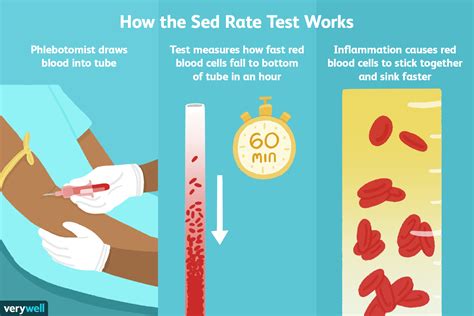The erythrocyte sedimentation rate (ESR), also known as the sed rate blood test, is a diagnostic tool used to measure the level of inflammation in the body. It is a non-specific test, meaning it does not diagnose a specific disease, but rather indicates the presence of an inflammatory process. A high sed rate can be caused by a variety of factors, including infections, autoimmune disorders, and cancers.
When a patient undergoes an ESR test, a blood sample is drawn and placed in a test tube with an anticoagulant to prevent clotting. The tube is then left to sit for a specified period, usually one hour, allowing the red blood cells to settle to the bottom. The rate at which the red blood cells settle is measured in millimeters per hour (mm/hr). The normal range for ESR varies slightly between laboratories but is generally considered to be 0-20 mm/hr for adults.
A high sed rate is typically defined as a result above 20 mm/hr, although this can vary depending on the individual’s age, sex, and other factors. For example, older adults may have a slightly higher normal range due to the natural aging process. It’s also important to note that ESR is not a diagnostic test for a specific disease but rather an indicator of inflammation.
There are numerous potential causes for a high sed rate, reflecting the test’s non-specific nature. These can be broadly categorized into several groups:
Infections: Bacterial infections, such as tuberculosis or pneumonia, and viral infections can cause an elevated ESR. The inflammation associated with these infections leads to the production of acute-phase proteins, which cause red blood cells to aggregate and settle more quickly.
Autoimmune Disorders: Conditions like rheumatoid arthritis, lupus, and Hashimoto’s thyroiditis canlead to a high sed rate due to the chronic inflammation they cause. In these diseases, the immune system mistakenly attacks the body’s own tissues, resulting in an inflammatory response.
Cancers: Certain types of cancer, including lymphoma and multiple myeloma, can cause an elevated ESR. The exact mechanism is not fully understood, but it’s thought that tumor cells can produce substances that stimulate the production of acute-phase proteins.
Chronic Diseases: Conditions like diabetes and chronic kidney disease can also result in a high sed rate due to the ongoing inflammation associated with these diseases.
Inflammatory Diseases: Diseases that cause inflammation, such as Crohn’s disease and ulcerative colitis, can lead to an elevated ESR.
It’s crucial to understand that a high sed rate alone does not provide enough information to make a diagnosis. It is used in conjunction with other diagnostic tests, medical history, and physical examination to determine the underlying cause of inflammation. Treatment depends on the specific cause of the elevated ESR and may involve addressing the underlying infection, managing the autoimmune disorder, treating the cancer, or controlling the chronic disease.
In addition to understanding the causes of a high sed rate, it’s also important to be aware of the limitations of the ESR test. It can be influenced by various factors, including age, anemia, and certain medications. For example, non-steroidal anti-inflammatory drugs (NSAIDs) and corticosteroids can suppress inflammation and thus may decrease the ESR, potentially masking an underlying inflammatory condition.
To manage or reduce a high sed rate, the primary approach is to treat the underlying condition causing the inflammation. This may involve a combination of medications, lifestyle modifications, and other interventions aimed at reducing inflammation and addressing the root cause of the elevated ESR.
For individuals looking to understand their ESR results better or how to manage a high sed rate, consulting with a healthcare provider is essential. They can provide personalized advice based on the individual’s specific condition, medical history, and test results. Additionally, maintaining a healthy lifestyle, including a balanced diet, regular exercise, not smoking, and managing stress, can help in reducing overall inflammation in the body.
In conclusion, a high sed rate indicates the presence of inflammation in the body, which can be caused by a wide range of conditions. Understanding the causes, limitations, and implications of an elevated ESR is crucial for both healthcare providers and patients. By combining the ESR with other diagnostic tools and treating the underlying cause of inflammation, individuals can effectively manage a high sed rate and improve their overall health.
Pros and Cons of ESR Testing
- Pros:
- Simple and inexpensive to perform
- Provides a general indication of inflammation
- Can be used to monitor the effectiveness of treatment
- Cons:
- Non-specific, does not diagnose a specific disease
- Can be influenced by various factors (age, anemia, medications)
- May not detect inflammation in all cases (e.g., early stages of disease)
What does a high sed rate indicate?
+A high sed rate indicates the presence of inflammation in the body, which can be caused by a variety of factors including infections, autoimmune disorders, and cancers.
How is the ESR test performed?
+The ESR test involves drawing a blood sample, which is then placed in a test tube with an anticoagulant. The tube is left to sit for a specified period, allowing the red blood cells to settle to the bottom. The rate at which the red blood cells settle is measured in millimeters per hour (mm/hr).
What are the limitations of the ESR test?
+The ESR test is non-specific and does not diagnose a specific disease. It can also be influenced by factors such as age, anemia, and certain medications, which may lead to inaccurate interpretations.
By understanding the significance of a high sed rate and the role of the ESR test in diagnosing and managing inflammatory conditions, healthcare providers and patients can work together to address the underlying causes of inflammation and improve patient outcomes. Regular monitoring and adjustments to treatment plans as needed can help in controlling inflammation and reducing the risks associated with chronic inflammatory diseases.


